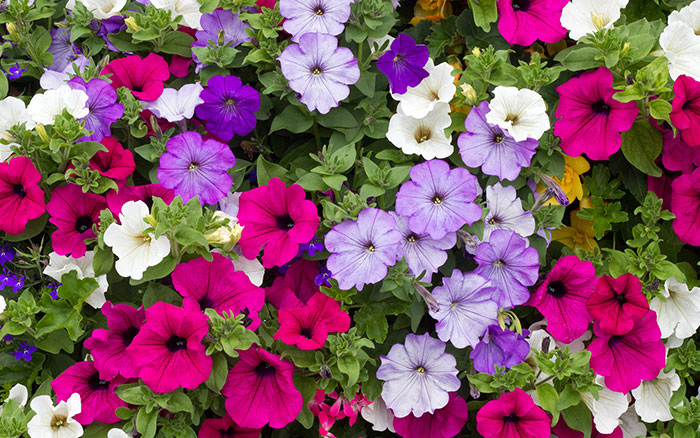September usually signifies the end of the summer holidays and a whiff of autumn in the air. It can feel like the garden has given all its summer offerings, but there’s plenty more colour to come!
With some planning, you can have different themed flower borders, bursting with vibrant colour, flowering right until the first frosts. Just use a mix of annuals and perennials for your late-summer garden.
Long-flowering annuals
Petunias, marigolds, and cosmos are all summer flowering annuals that can continuously produce flowers from early summer to late autumn.
Most are easily grown from seed. Marigolds (Calendula) in particular, are also likely to set seed in late-summer.
Many, if left undisturbed, will grow, and flower the following year, making them remarkable value as well as prolific flowerers.



Annual climbers tend to come into their own this time of the year displaying red, yellow and orange colour flowers. They grow fast and are a delightful way to add height as well as late summer colour to the garden.
If you’ve moved into a new house or created a new border, climbing annuals are a great way to give temporary instant impact whilst waiting for shrubs and perennial plants to establish.
Examples are Cathedral Bells (Cobaea scandens), Black-eyed Susan (Thunbergia alata) and Morning Glory (Ipomoea tricolor).



Late-summer Perennials
There is a category of perennial plants that don’t start to flower until late-summer. And they make a colourful impact when flowering en masse! Dahlias are an obvious choice. There are tens of thousands of named varieties to choose from in a range of colours, flower shapes and sizes.
They grow from tubers and, given their hot climate origins, need to be grown in full sun. They’re hungry plants so give them rich soil and feed regularly with a high potassium feed whilst in flower.
They’ll either need lifting from the ground and storing over winter or, if left in the ground, thoroughly protected. Protecting them from prolonged winter wetness and frost can be done with a deep mulch of leaves or well-rotted manure.
The good news is that you can wait until after the first frost before lifting or protecting. This means their vibrant colours can be enjoyed from now right up to November.
If you want to grow them as cut flowers, choose varieties that have long stems and a long vase life. The ‘ball’ or ‘pompon’ shape flower types like ‘Sebastian’, ‘Cornel Brons’ or ‘Dark Spirit’ make particularly good cut flowers.



There are many other flowers traditionally associated with a cottage garden theme happily in full flower now. Examples include phlox, penstemon and helenium.
Sedum (now renamed Hylotephium) flowers start to colour up now in shades of ruby red and, sometimes white. Much beloved by bees and pollinators, keep the flower heads on the plant after they’ve finished flowering. They provide winter food for the birds as well as late-season interest in the flower border.

If you have an area planted with different types of ornamental grasses, adding late-season North American flowering plants can bring vibrancy to that area. Especially as many grasses will now also be flowering.
Rudbeckias come in a range of heights and shades of yellow through to orange-red. ‘Prairie Glow’ produces pretty orange/red flowers atop tall, narrow, flower stems. Whereas ‘Goldsturm’ is a shorter, stockier variety with bright yellow petals.
Achilleas are easy-to-grow, long-flowering perennials that fit in well with a prairie plant scheme. They’ll flower from early summer to late autumn if the spent flowers and stems are cut to the plant base.
Joe Pye Weed (Eupatorium) and Ironweed (Vernonia fasciculata) are both tall, purple flowering, back-of-border prairie plants beloved by pollinating insects.



For a holiday theme…
If you like the tropical look, late-summer is the best time for striking flowering perennials.
Cannas are another late-season flowering favourite that when in flower, can reach statuesque heights of up to 2.3m!

There are many varieties to choose from, often with large, distinctly marked, oval leaves like Canna ‘Striata’. But Canna ‘Erebus’ is a perfect choice for a more delicate look, with soft blue-green leaves and coral-pink flowers.
It is also possible to leave cannas in the ground over winter. But they need to be cut down before the first frosts and covered with a 15cm thick layer of mulch.
In colder parts of the country, it’s better to lift and store, again before the first frosts hit.
Ginger lilies (Hedychium) are another group of dazzling plants that produce impactful flowers at this time of year.
During early to mid-summer the plants throw out tall, upright stems with large leaves that quickly fill a border. This provides an instant jungle effect, followed by colourful, highly scented flowers.
There are many different types of Ginger Lily to choose from, all with sweetly scented blooms. The shaving brush ginger (Hedychium ellipticum) can reach heights of up to 2.5m topped by wispy, showpiece flowers.
The Kahili Ginger Lily (Hedychium gardnerianum) is one of the hardiest currently available bearing yellow flowers with contrasting red stamens.

Whether you are choosing your plants to suit a specific design, or just for colour, there are plenty of beautiful late-summer flowering plants for you to try.

Leave A Comment